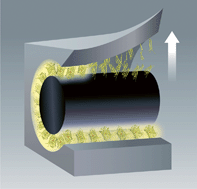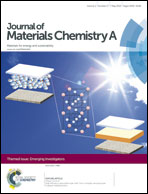Mechanical unfolding of a fluorescent protein enables self-reporting of damage in carbon-fibre-reinforced composites†
Abstract
Carbon-fibre-reinforced polymer composites with an enhanced yellow fluorescent protein (eYFP) at the interface of fibres and resin were prepared. The protein was immobilized on the carbon fibres by physisorption and by covalent conjugation, respectively. The immobilized eYFP fluoresced on the carbon fibres, in contrast to non-protein fluorophores that were fully quenched by the carbon surface. The fibres were embedded into epoxy resin, and the eYFP remained fluorescent within the composite material. Micromechanical tests demonstrated that the interfacial shear strength of the material was not altered by the presence of the protein. Immunostaining of single fibre specimen revealed that eYFP loses its fluorescence in response to pull-out of fibres from resin droplets. The protein was able to detect barely visible impact damage such as fibre–resin debonding and fibre fractures by loss of its fluorescence. Therefore, it acts as a molecular force and stress/strain sensor at the fibre–resin interface and renders the composite self-sensing and self-reporting of microscopic damage. The mechanoresponsive effect of the eYFP did not depend on the type of eYFP immobilization. Fibres with the physisorbed protein gave similar results as fibres to which the protein was conjugated via covalent linkers. The results show that fluorescent proteins are compatible with carbon fibre composites. Such mechanophores could therefore be implemented as a safety feature into composites to assure material integrity and thereby prevent catastrophic material failure.

- This article is part of the themed collection: Emerging Investigators

 Please wait while we load your content...
Please wait while we load your content...